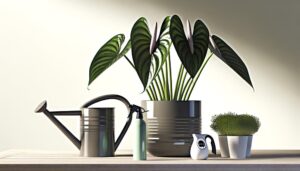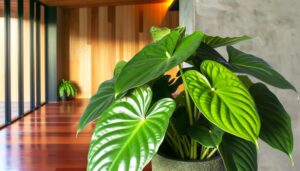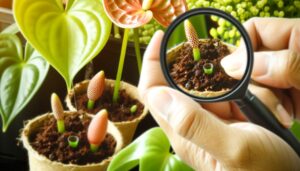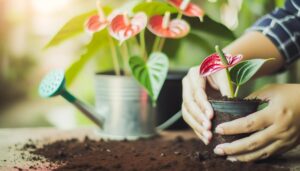7 Essential Tips for Anthurium Flamingo Flower Care
To care for Anthurium Flamingo Flowers, water deeply but let the top inch of soil dry out. Provide bright, indirect light and rotate the plant for even growth.
Maintain humidity levels between 60-80% using a humidifier or water tray. Use a potting mix with orchid bark, peat moss, and perlite, and repot every two years.
Feed with a diluted, balanced fertilizer every 6-8 weeks. Keep leaves clean and inspect regularly for pests like spider mites and aphids, treating as needed.
Make sure you understand all these aspects for thriving Anthurium Flamingo Flowers. There’s more to explore for perfect results.
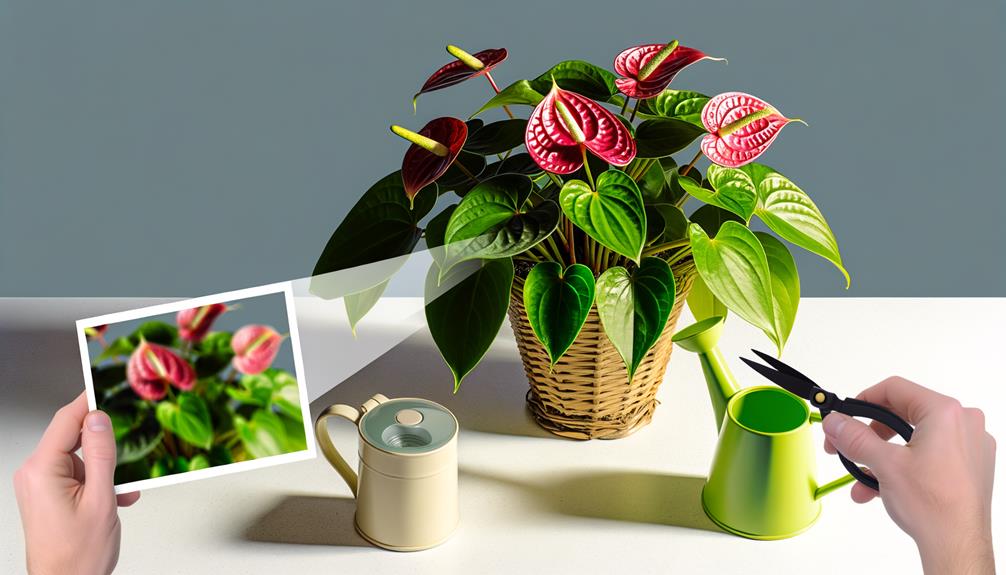
Key Takeaways
- Water thoroughly but let the top inch of soil dry out between watering.
- Provide bright, indirect light; avoid direct sunlight to prevent leaf damage.
- Maintain humidity levels between 60-80% using a humidifier or water tray.
- Use a well-draining potting mix with orchid bark, peat moss, and perlite.
- Fertilize every 6-8 weeks with a balanced, water-soluble, 20-20-20 N-P-K ratio fertilizer.
Proper Watering Techniques

To safeguard the thriving of your Anthurium Flamingo Flower, you’ll need to water it thoroughly but allow the top inch of soil to dry out between waterings. Utilize tepid, filtered water to prevent root shock. Confirm water penetrates deeply, encouraging robust root growth. Monitor soil moisture with a hygrometer for precision.
Avoid waterlogging; employ a well-draining potting mix to facilitate aeration. Excess moisture can lead to root rot, a fatal condition for Anthuriums. If using a saucer, empty it after watering to prevent stagnant water.
During the growing season, increase watering frequency but remain vigilant against overwatering. In contrast, reduce watering in winter as the plant’s metabolic rate slows. Consistent watering practices will secure your Anthurium remains vibrant and healthy, enhancing its ornamental appeal.
Ideal Light Conditions
Ensuring your Anthurium Flamingo Flower thrives also requires providing it with bright, indirect light to mimic its natural tropical habitat. Place your plant near an east or north-facing window where it can receive ample diffused sunlight.
Direct sunlight can scorch the leaves, so avoid placing it in a spot where it will be exposed to harsh, midday rays. If natural light is insufficient, consider using a grow light with a spectrum tailored for tropical plants. An ideal light intensity ranges between 10,000 to 20,000 lux.
Rotate the plant occasionally to promote even growth. Remember, consistent exposure to the right light conditions not only enhances the vibrant blooms but also maintains the plant’s overall health and vigor.
Humidity Requirements
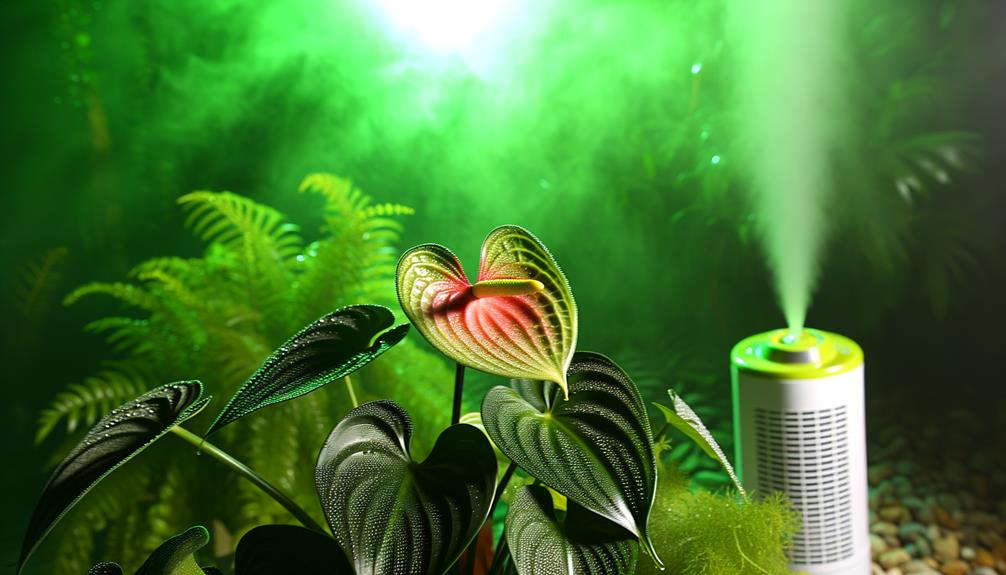
To guarantee your Anthurium thrives, maintain humidity levels between 60-80%. Increase air moisture by using a humidifier or placing the plant on a tray of water and pebbles.
Watch for signs of low humidity such as brown leaf tips and slowed growth.
Optimal Humidity Levels
Maintaining anthurium flamingo flowers at a humidity level of 60-80% is important for their best growth and vibrant blooms. You’ll want to monitor ambient humidity with a hygrometer to make sure it stays within this range consistently.
Low humidity causes browning leaf tips and stunted growth. Inadequate moisture leads to reduced flowering and overall plant stress. Place your anthuriums in a naturally humid environment, such as a bathroom or kitchen, to help maintain ideal levels.
Additionally, avoid placing them near air vents or drafty windows, which can decrease humidity. Your diligence in monitoring and maintaining these conditions ensures your anthuriums thrive, offering stunning blossoms and lush foliage, thereby enhancing the beauty of the spaces you care for.
Increasing Air Moisture
Wondering how to effectively increase air moisture for your anthurium flamingo flowers?
Position a humidifier nearby to maintain a consistent relative humidity of 60-80%.
Place a shallow tray filled with water and pebbles under the plant pot; this creates a micro-humid environment through evaporation.
Group your anthuriums with other humidity-loving plants to take advantage of natural transpiration.
Mist the foliage daily using distilled water to avoid mineral deposits.
You can also utilize a humidity tent or plastic bag during dry periods, ensuring it’s ventilated to prevent mold.
Monitor humidity levels with a hygrometer, adjusting methods as necessary.
These strategies ensure your anthuriums receive the best moisture they need, promoting vibrant blooms and healthy growth.
Signs of Low Humidity
Your anthurium flamingo flowers will exhibit drooping leaves, browning edges, and stunted growth as telltale signs of low humidity. The ideal humidity level for anthuriums is between 70-80%. When levels drop below this range, cellular dehydration occurs, leading to the aforementioned symptoms.
To diagnose low humidity, regularly check a hygrometer placed near the plant. If the humidity is insufficient, mist the leaves daily with distilled water or use a humidity tray. Alternatively, place a humidifier nearby to maintain consistent moisture levels.
Soil and Potting Mix
When preparing the soil and potting mix for your Anthurium Flamingo Flower, make sure it contains a mix of orchid bark, peat moss, and perlite to provide aeration and moisture retention.
You’ll need to incorporate proper drainage techniques to prevent root rot, such as using pots with drainage holes and a well-draining mix.
For best growth, follow top potting practices by repotting every two years to refresh the soil and accommodate the plant’s expanding root system.
Ideal Soil Composition
A well-draining potting mix, rich in organic matter and slightly acidic, is essential for the best growth of Anthurium Flamingo Flowers.
Start with a base of orchid bark and add sphagnum peat moss to enhance moisture retention.
Incorporate perlite or charcoal to improve aeration and prevent soil compaction.
Aim for a pH range of 5.5 to 6.5 to optimize nutrient absorption.
Mix in some pine bark or coconut coir for added structure and organic content.
Avoid heavy garden soils as they retain too much moisture and can lead to root rot.
Proper Drainage Techniques
Ensuring proper drainage in your Anthurium Flamingo Flower’s potting mix is important to preventing root rot and promoting healthy growth. Start by using a well-aerated, chunky mix containing orchid bark, perlite, and peat moss. This combination provides sufficient aeration and moisture retention.
Avoid heavy soils that compact easily, as they restrict root oxygenation. Incorporate a layer of gravel or small stones at the bottom of the pot to facilitate swift water movement away from roots. Make sure your pot has multiple drainage holes to prevent water pooling.
Regularly check the drainage efficiency by watering the plant and observing the outflow. If water stagnates, adjust the mix or pot to enhance drainage. Proper drainage techniques are important for your Anthurium’s health.
Best Potting Practices
Selecting an appropriate potting mix for your Anthurium Flamingo Flower involves combining materials that promote both moisture retention and aeration, such as orchid bark, coconut coir, and perlite. Start by mixing equal parts of orchid bark and coconut coir to strike a balance of water-holding capacity and drainage.
Add perlite to the blend, about 20% by volume, to enhance aeration and prevent root rot. Choose a pot with drainage holes to facilitate excess water escape. Fill the pot one-third full with your mix, place the Anthurium so its roots are spread evenly, and then fill around the roots without compacting the mix.
Water thoroughly after potting, ensuring water drains freely to establish ideal growing conditions.
Fertilizing Schedule
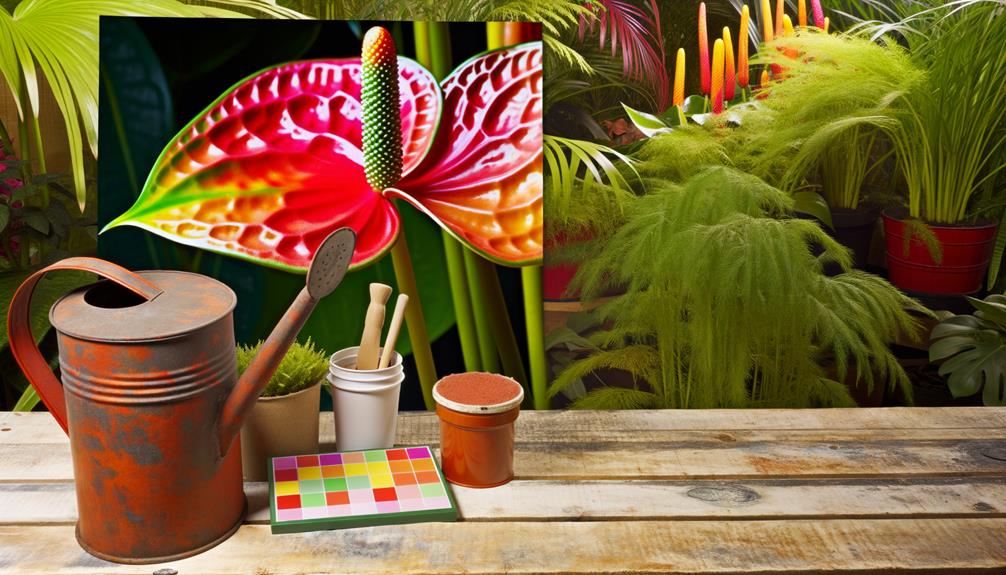
To maintain ideal growth and vibrant blooms, feed your Anthurium Flamingo Flower a balanced, water-soluble fertilizer every six to eight weeks during the growing season. Make sure you use a fertilizer with an N-P-K ratio of 20-20-20 for best nutrient balance. Dilute the fertilizer to half strength to prevent root burn and nutrient overload.
Here’s a simple fertilizing schedule to follow:
- Early Spring: Begin feeding as new growth appears. This kickstarts the plant’s growth cycle.
- Summer: Continue fertilizing bi-monthly to support blooming and foliage health.
- Fall: Gradually reduce the frequency as the plant’s growth slows.
Pruning and Cleaning
Regular pruning and cleaning are crucial to maintaining the health and aesthetics of your Anthurium Flamingo Flower. Begin by using sterilized pruning shears to remove any dead or yellowing leaves, cutting close to the base to prevent disease.
Trim spent flowers to encourage new blooms. Carefully wipe each leaf with a damp cloth to remove dust, enhancing photosynthesis efficiency. Inspect the stems and leaves for any signs of decay or damage, addressing issues promptly.
Make sure you dispose of all pruned material properly to avoid potential pest infestations. Regularly cleaning the plant’s surroundings and monitoring humidity levels will further support its essentiality.
Your diligent care will ensure your Anthurium remains vibrant and healthy, serving as a beautiful focal point.
Common Pests and Diseases

Encountering pests and diseases such as spider mites, aphids, and root rot can greatly impact the health of your Anthurium Flamingo Flower. To maintain its health, you must take proactive steps.
Spider Mites: Inspect leaves regularly. If you notice fine webs, isolate the plant and wash the leaves with mild soapy water.
Aphids:These pests often cluster on new growth. Use an insecticidal soap or neem oil spray to eliminate them.
Root Rot: Overwatering is the main cause. Ensure the soil is well-draining and let it dry out between waterings. Prune any affected roots and repot the plant with fresh, sterile soil.
Conclusion
By following these essential tips for anthurium flamingo flower care, you’ll cultivate a vibrant, thriving plant.
Water wisely, light it just right, and maintain high humidity.
Use a well-draining potting mix, fertilize regularly, and keep your plant pruned and clean.
Vigilantly guard against pests and diseases.
Your anthurium will flourish like a tropical oasis in your home, showcasing its radiant blooms and lush foliage, a proof of your expert nurturing skills.


